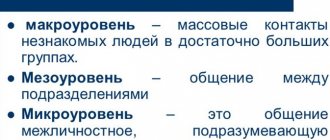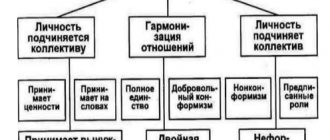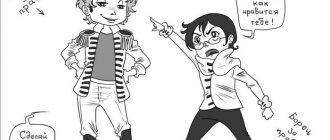Do you know what role each person plays on your team and what you can learn from them? In addition to the formal job role (functions and responsibilities described in the job description), people in the group can also take on a second, team role. Let's figure out what it is and how to use roles to improve the team's work.
Often team roles develop over time, informally, and therefore may go unnoticed. However, a team role summarizes how people tend to behave, how they contribute, and how they will interact with the team over a period of time. For example, one team member may be constantly coming up with new ideas, another may be good at developing contacts outside the team, and another may be great at translating ideas into action. Over time, patterns develop in any team where the same person repeatedly takes on a specific role that others then expect him to perform.
In other words, team roles are an attempt to classify personality types so that the strengths and weaknesses of team members can be identified and recognized
The basis for determining what functions people perform in a group is traditionally considered to be the model of Raymond Meredith Belbin, Doctor of Psychology, Emeritus Professor at the Universities of Bristol and Exter, Advisor to the UN and the European Community Commission on Team Roles or Functions, which he presented in the 80s years of the last century.
In total, Belbin identified nine group roles, or groups of behavior, dividing them into three groups: action-oriented, people-oriented, and thought-oriented. Each team role is associated with typical behavioral and interpersonal qualities. Belbin also identified the characteristic weaknesses inherent in each team role: he called them “acceptable” weaknesses—areas to be aware of and potentially improve.
Group objectives and norms
Tasks are determined by the general system of work in the group. For example, improving communication skills, interpersonal style of interaction, etc. There are general tasks determined by the specifics of group psychocorrection:
- Studying the psychological problems of each person in the group and providing assistance in solving them.
- Changing maladaptive behavior patterns and achieving adequate social adaptation.
- Acquiring knowledge about interpersonal and group processes to interact more effectively with people.
- Promoting the process of personal growth.
- Elimination of painful symptoms corresponding to various emotional problems.
Norms are accepted rules of behavior that guide the actions of participants and determine sanctions and punishment for their violation. The stricter the norms and the harsher the punishment, the more authoritarian the group. Each group has its own norms, but openness, empathy, truthfulness, and warmth are encouraged, on which the effectiveness of the group depends. An individual who does not comply with the group’s norms finds himself in the position of a deviant, whom the group tries to subordinate to the rules and then excludes. The presenter immediately introduces the participants to the rules of work, adherence to which meets psychocorrectional goals. Their implementation is necessary to protect participants from negative group experiences and possible traumatic experiences. The following standards of behavior are discussed: Ш Frankness and sincerity. You can’t tell a lie; it’s better to just not tell it. Ш Not using “shortcuts”. Participants should strive for understanding, not judgment. It is necessary to talk about individual aspects of a person’s behavior, and not evaluate it globally in order to avoid insults. Ш Constructive feedback. Expressed in the communication of one’s feelings, even negative ones. Ш Control of behavior. “Everything can be talked about, but not everything can be done.” “You cannot show your emotions uncontrollably, especially aggressive and sexual ones.” In some classes, the realization of feelings is encouraged, but under control. Ш Responsibility. Each group member takes responsibility for other group members. Ш Rule "STOP". Each participant has the right, without any explanation, to stop any conversation concerning his person. Ш Maintain confidentiality. Sh Tolerance. Participants must be tolerant of all outspoken opinions of other group members.
Action-oriented roles
Shaper
Shapers are people who challenge the team to become better. They are typically dynamic and extroverted individuals who enjoy stimulating others, challenging norms, and finding the best approaches to solving problems. The shaper is the one who shakes up the team and goes through everything inside and out to make sure that all possibilities are fully taken into account. Shapers often view obstacles as exciting challenges and tend to have the courage to overcome them when others are ready to give up.
Their potential weaknesses may be that Shapers are argumentative, impatient, and may hurt people's feelings.
Implementer
Implementers are people who get things done and turn the team's ideas and concepts into practical actions and plans. They are usually conservative, disciplined people who work systematically and efficiently and are very well organized. You can always count on them to get the job done.
The downside is that they can get stuck in their ways and are not always open to new ideas and ways of solving problems: in any case, they would rather stick to old, tried and tested methods than embrace change and innovation.
Pedant
Pedants are people who are task-oriented and ensure that projects are completed completely and that there are no errors or omissions. They pay attention to the smallest details, are concerned with deadlines, and push the team to get the job done on time. Often called perfectionists, they are orderly and conscientious.
However, they are often overly anxious people who have difficulty delegating tasks. All other things being equal, they would rather do something themselves and know that the job will probably be done correctly than entrust it to someone else.
4.Group roles
Roles are behaviors adopted by group members and viewed by them as consistent with the group's interests. The client's role in the group is usually different from the role he plays outside the group. This requires psychological restructuring, understanding the need for a new role, and, when accepting it, flexibility in role tactics.
Group roles according to R. Schindler. a - a leader who impresses the group, motivates it to action, sets a program and gives courage. b- an expert who has the special knowledge, skills and abilities that the group needs or respects. His behavior is rational, self-critical, neutral. c- passive and adaptable group members. d - the most “distant” member of the group, lags behind it due to difference from the rest or fear, sometimes identified and united with the enemy, which provokes the group. The enemy is a symbolic representative of the opposing enemy group or a deviant. In a psychocorrectional group, they strive to recognize the roles of each participant - neurotics repeat their roles (they are stereotypical). D. Moreno identifies three main roles of a leader in a group: 1. Leader in leadership ability (characterized as calm, intelligent, rational, active, reliable). 2. Leader in popularity (sociable, cheerful, exciting, warm-hearted). 3. “black sheep” - a person who is unattractive, indifferent, unsympathetic and negative to the rest of the group members.
Role combination and role conflict
Since one person usually performs many roles, role tension, inconsistency, or even role conflict arises between some of them. After all, some roles contradict each other in content and form.
If a performer subjectively moves away from his role, role distance arises, even to the point of “leaving the role” (for example, an office romance). In a complex case, the roles are perceived as almost incompatible (military chaplain or teacher and researcher).
When creating the story of his life, a person proceeds from his main roles.
It is in such an “autonarrative” with its single plot that it is possible to search for a compromise between the roles and determine ways to optimally combine them.
The role structure includes:
- The cognitive component, that is, the understanding of what, why and how a person should do under certain circumstances.
- The prognostic-evaluative component, that is, a vision of the ideal, the ability to optimize the role.
- A conative component that reproduces the attitude towards oneself as an active, independent, responsible performer of a role.
A role can help a person gain sympathy and find support. It happens that a person in a role “on duty” can show more purposefulness, determination, and integrity than outside of it. At the same time, you can hide behind a role, like behind a mask, so as not to show your true attitude, to hide fear, anger or uncertainty.
Group voltage
During activities, group members can oppose each other in views, relationships, etc. Antipathy, hostility, aggressiveness, and conflicts appear between group members, participant and leader. Group tension is associated with the internal tension of each individual in the group. In group psychocorrection, aggression is not suppressed, but they try to identify it either verbally (a story about these feelings) or in symbolic form (additional objects are used: the client hits a pillow, which is a symbol of the person - the subject of aggression). If tension in a group is high and is not replaced by cohesion, then this leads to the disintegration of the group. Low voltage is also negative, because work on oneself is slowed down, group members are satisfied with the relationship, and try not to notice the complexes. A psychocorrectional group needs constant conflicts, mutual criticism and confrontation of its members. Group cohesion is a stabilizing factor that provides support and relative safety. Group tension is a motivating factor that provides dissatisfaction and the desire to change something. The psychologist must control the dynamic balance between these factors.
Correspondence
Conformity can be stated as "adjustment to group pressure." This is also called majority influence or we can say group pressure.
It is widely used to indicate agreement with the majority position, driven either by a desire to fit in, to be loved, or to be correct or simply conform to a social role.
Types of Social Conformity
Three types of correspondence can be distinguished:
- Regulatory Compliance
- Information compliance
- Ingritational compliance
Regulatory Compliance
Giving in to group pressure because the person wants to fit into the group. Conformity usually occurs because the individual fears being rejected or neglected by the group.
This type of conformity typically involves conformity, such as when a person publicly accepts the group's views but privately rejects them.
Information compliance
This usually happens when a person lacks knowledge and turns to a group for advice. Or when a person does not understand the situation and socially compares his behavior with the group.
This type of conformity involves internalization, such as when a person accepts the views of groups and accepts them as an individual.
Ingritational compliance
Where a person fits in to receive favor or acceptance from other people. This is associated with normative influence, but is encouraged by the need for social rewards rather than the threat of rejection.
In other words, group pressure is not always a reason to conform.
Harvard psychologist Herbert Kelman identified three different types of conformity:
- Compliance
- Socially altering behavior to conform to the group while disagreeing privately. Simply put, in accordance with the masses, despite actually disagreeing with them.
- Internalization
- Socially modifying behavior to fit in with the group as well as agree with them privately.
- Identification
— agreement with social role expectations. This appears to be compliance, but there is no change in private opinion.
Compliance
- Socially altering behavior to conform to the group while disagreeing privately. Simply put, in accordance with the masses, despite actually disagreeing with them.
Internalization
- Socially modifying behavior to fit in with the group as well as agree with them privately.
Identification
— agreement with social role expectations. This appears to be compliance, but there is no change in private opinion.
How to assemble a working team using the Belbin model
After assessing and identifying the team roles of employees, you can begin to form a work team. The procedure for selecting participants directly depends on the company’s mission and it is recommended to start the selection with the most significant team roles for a specific purpose. And then, based on the characteristics of the leading roles, the remaining team members are selected, who will complement and balance the first participants. Let's look at examples.
If the task is “introducing a new product to the market” or “developing an anti-crisis strategy,” then the first roles will be played by the intellectual roles: Idea Generator, Strategic Analyst and Specialist. The Generator will put forward an idea, the Analyst will analyze the market and provide an opinion on how viable the Generator’s idea is, and the Specialist will give his recommendations on how to implement the plan.
For the tasks of “searching for new partners/suppliers” or “opening a new store/branch,” the following social roles will be indispensable: Resource Researcher, Coordinator and Soul of the Team, because they are focused on establishing contacts between people and building long-term business relationships.
When forming a team, balance is important so that the strengths of some members can compensate for the weaknesses of others. For example, the Analyst will periodically bring down the Idea Generator “from heaven to earth”, the Soul of the Team will help the Pedant cope with unnecessary anxiety, and the Motivator will inspire the Implementer when he, due to a dislike for the new, resists change.
Approach creatively when creating a work team, because an organically formed team is able to effectively cope with any task.
The predominance of public interest over personal interest: the formation of a team
The team is a group with a high level of development. To achieve this stage of community, it is necessary to act consciously and follow the plan, obey the requirements of the leader.
The team is characterized by:
- unity of motives and goals aimed at mutual assistance and support;
- conditions for personal development;
- group nature of the activity;
- voluntary and positive interaction;
- joint development of ways to achieve the goal.
To become a collective, a community must go through the following stages of development:
- The moment of occurrence.
- Naming.
- Emotional integration.
- Unity of purpose.
- Integration of goals into general social ones.
At the last stage, the interests of individuals become focused on a global goal and move to the stage of a pseudo-collective, for which personal goals are more important than public ones.
Productive communication within a team occurs due to the process of perceiving a person by a person - the formation of an image that arises during direct communication.
Perceptual mechanisms that enable interpersonal communication include:
- Identification is likeness to another individual, a primitive form of attachment. The object of identification can be either a real person or a fictional character.
- Empathy is penetration into a person’s emotional state, sharing his feelings.
- Reflection is an assessment of one’s own mental state, analysis of the impression made on team members.
- Attraction is the formation of attachment based on the attractiveness of one individual to another.
In a developed team, an individual works for public interests, but gets the opportunity to develop his strengths. The team works as a well-coordinated team, directing its main aspirations towards universal human interests.
Belbin's nine roles classification: who's who
Intellectual roles
- An idea generator is an inventor and innovator. As a rule, this is the team leader. Useful in the initial stages of a project, or when the workflow has stalled and a driver is needed to keep moving;
- The strategic analyst is objective and insightful. Analyzes project opportunities and rarely makes mistakes in assessing the situation. Cold-blooded, often introverted. Useful at the strategic planning stage;
- A specialist is a dedicated expert. Shares the necessary knowledge with the team, a professional in his field. Useful at the beginning of a project when you need to check technical nuances.
Social roles
- The soul of the team is soft and diplomatic. Popular person on the team. Has empathy, creates a friendly atmosphere in the team, helps resolve conflicts between colleagues;
- The resource explorer is a charismatic enthusiast and extrovert. Able to build relationships, competently negotiate and negotiate favorable terms with contractors or new clients;
- The coordinator is a confident organizer. This is usually the team leader. He distributes tasks, sets deadlines, and controls the results. He knows his team well and skillfully uses the capabilities of each employee.
Action roles
- Motivator - energetic and success-oriented. Such an employee himself has a high level of motivation and motivates others. He likes to lead the team and does a good job of it. Does not tolerate failures and reacts sensitively to them;
- The implementer is a disciplined and hardworking performer. A real soldier. You can always rely on such a person, he will complete the task on time and do exactly what is asked of him, he is conservative. Always use common sense when performing tasks;
- A pedant or controller is conscientious and anxious. This employee, as a rule, completes the project and “combs” the work of the entire team. He is neat and attentive, demanding of details, does not like to delegate, and is a perfectionist. He is a calm introvert on the surface, but inside he often worries, sometimes more than necessary. The pedant is passionate about results and approaches his work responsibly.
What to remember
- If several people in a work team duplicate each other in roles and functions, ineffective distribution of resources within the group occurs and overall performance decreases. Belbin's theory of team roles is designed to address this problem;
- Belbin's model consists of 9 types and is divided into 3 groups: intellectual roles - Idea Generator, Strategic Analyst, Specialist; social roles - Soul of the team, Resource Explorer, Coordinator; action roles - Motivator, Implementer, Pedant;
- In order to identify team roles among employees, it is recommended to use a personnel test assessment. Different factors are important for different roles, so the assessment should be comprehensive and consider a person in three areas: motivation, intelligence, personality;
- After the assessment, you can form a team. Start with the most important role for the project, and then select the remaining participants so that they complement each other's qualities and neutralize each other's shortcomings. The balance of power of the entire team is important here;
- Belbin's team role model will help form an organic work team that will be able to effectively cope with assigned tasks and regularly bring benefits to the company.
Group sizes: features of interaction between individuals depending on quantitative characteristics
Modern group psychology distinguishes 3 types of communities based on the number of people:
- Big - a large association, the relations within which are formal, but not stable. Belonging to such associations provides socially significant attitudes, rights and responsibilities. Large groups include the state, professional associations, and religious communities.
- Small is the main form of the collective, determining the individual’s opinion about himself and his place in society. A small community creates a standard of thinking and behavior that a person strives to conform to.
- Microgroup - consists of 2-3 individuals. It has all the characteristics of a group; the nature of relations between members is informal, based on trust, respect, and mutual sympathy.
As individual qualities develop, a person may move from one group to another or try to change the characteristics of the association in which he initially found himself.
What is the Belbin Team Role Model?
Raymond Meredith Belbin, PhD, director of Belbin Associates Ltd, created a theoretical model of team roles in the 1960s and 1970s. It consists of 9 types and is divided into 3 groups: intellectual roles - Idea Generator, Strategic Analyst, Specialist; social roles - Soul of the team, Resource Explorer, Coordinator; action roles - Motivator, Implementer, Pedant.
The main idea of the model: a work team is most effective when it consists of people with different abilities, ways of thinking and personal qualities. At the same time, it is important that team members not only differ, but complement each other. Then the process will work according to the principle of a conveyor belt, where each employee performs his specific functions in the project, and then passes it on further along the chain.
When a business process is established in a team, none of the employees waste time, do double work or compete with each other. Each participant understands his role and does exactly what the manager and his team expect of him.
Let's take a closer look at each team role, functions, pros and cons.
Reference groups
It is the group to which a person or another group is compared. Reference groups are used to study and determine personality or other characteristics and sociological characteristics of other groups.
This is the group to which a person belongs or seeks to psychologically associate himself. This becomes the individual's guide and source for drawing on his or her experiences, perceptions, needs and self-images.
These groups act as a standard and contrast necessary for comparing and assessing group and personal characteristics.
Social laziness
This is a phenomenon where people put in less effort to achieve a goal when they work in a group than when they work alone.
This is one of the main reasons why groups are sometimes less productive than the aggregate performance of their members working individually, but it must be understood by the occasional coordination problems that groups sometimes encounter.
Many of the causes of social loafing arise from the individual's feeling that his or her efforts will not make a difference to the group.









